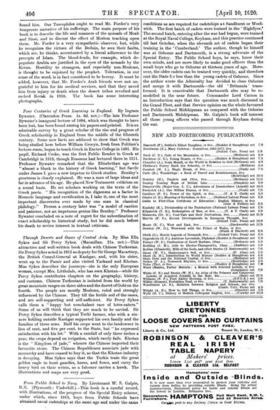From Public School to Navy. By Lieutenant W. S. Galpin,
R.N. (Plymouth : Underhill.)—This book is a careful record, with illustrations, of the progress of the Special Entry scheme, under which, since 1913, boys from Public Schools have obtained naval cadetships at the same age and under the same
conditions as are required for cadetships at Sandhurst or Wool- wich. The first batch of cadets were trained in the Highflyer.' The second batch, entering after the war had begun, were trained at the Royal Naval College, Keyham, and this practice continued till last October, when the eleventh set of cadets began their training in the ` Cumberland.' The author, though he himself was at Osborne and Dartmouth, is a strong advocate of the Special Entry. The Public School boys, he says, know their own minds, and are more likely to make good officers than the small boys who go to Osborne at thirteen years of age. More- over, the older cadets can be trained very quickly, and therefore cost the State kr less than the young cadets of Osborne. Since the author wrote the Admiralty has decided to close Osborne and merge it with Dartmouth—the old ' Britannia ' trans- formed. It is conceivable that Dartmouth also may be re- modelled in the 'near future. Commander Lord Curzon in an Introduction says that the question was much discussed in the Grand Fleet, and that Service opinion on the whole favoured the Public School Midshipman as compared with the Osborne and Dartmouth Midshipman. Mr. Galpin's book will interest all those young officers who passed through Keyham during the war.


































 Previous page
Previous page